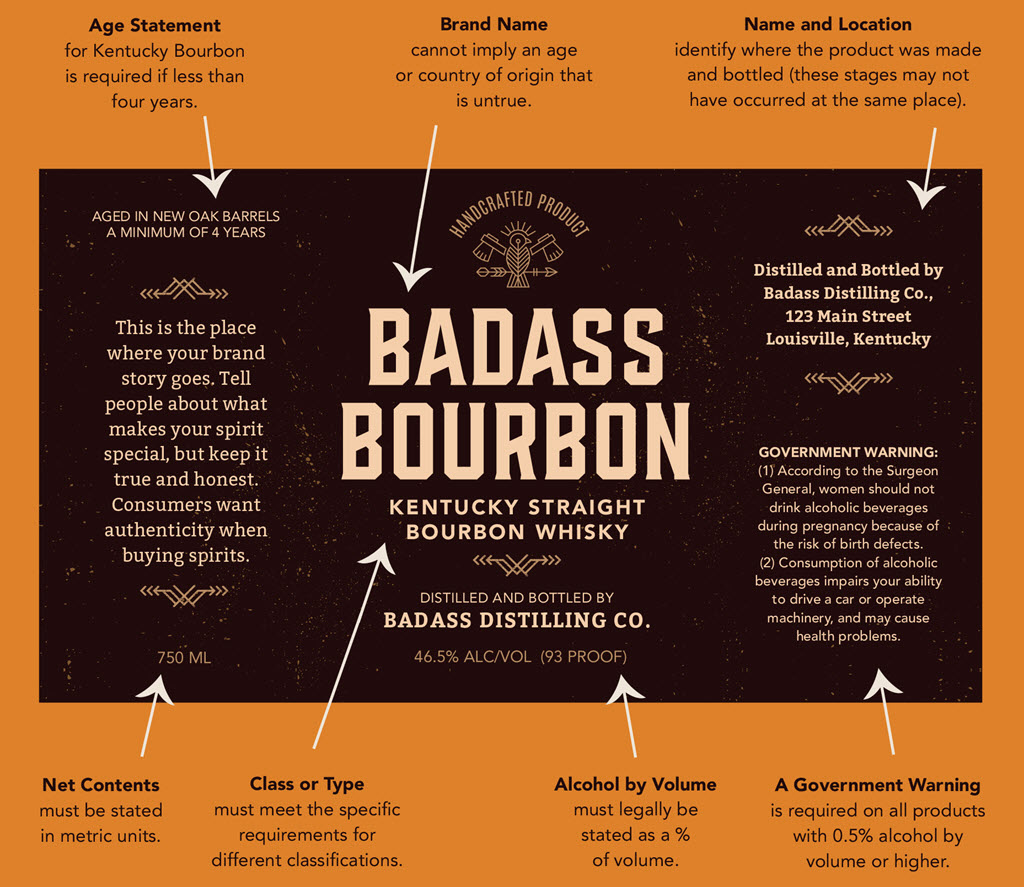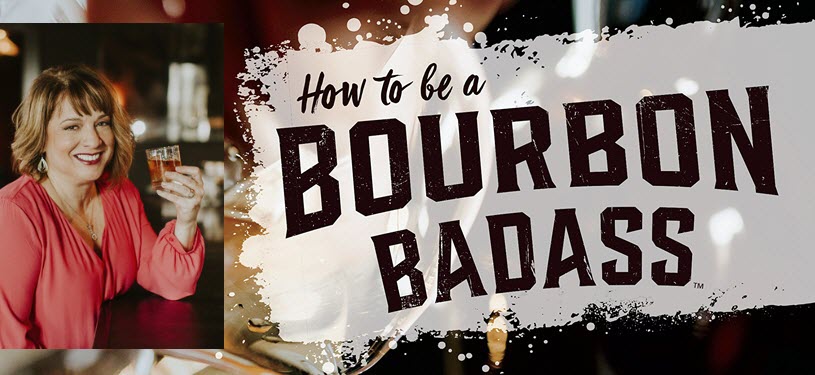
Similar to many journeys in life, your bourbon journey should be looked at as a marathon, rather than a sprint. And, just like a good Bottled in Bond bourbon that takes four years in a barrel quietly tucked away in a rickhouse, your bourbon journey will take time, patience and experimentation but will pay off for you over and over as you learn the fine art of becoming a “Bourbon Badass!”
In her first book, How to Be a Bourbon Badass, Linda Ruffenach, Founder of Whisky Chicks, (incidentally, it was founded four years ago, just like a good BIB bourbon) takes readers on a journey with tales from legendary master distillers as well as some up and coming rock stars that are shaking up the industry. She helps to educate readers on how bourbon is made, how to read a bourbon label, and how to order bourbon – neat, on the rocks or with a twist – all without feeling intimidated. And to help you on your bourbon journey there are several classic cocktail recipes as well as a chapter dedicated to the Suppa Club because not only can you enjoy drinking your bourbon but, you can eat it too.
A Bourbon Book for the Novice, Enthusiast and Connoisseur
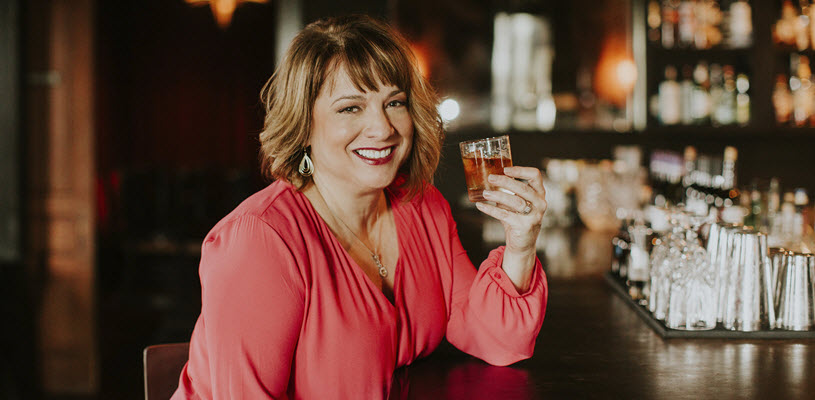
Linda Ruffenach Founder of Whisky Chicks.
Stay Informed: Sign up here for the Distillery Trail free email newsletter and be the first to get all the latest news, trends, job listings and events in your inbox.
We talked to Linda Ruffenach to help us understand who the book was geared toward. Linda said, “There are many amazing books on the market related to bourbon but most are geared towards the connoisseur or the collector. I wanted to create something that was interesting and approachable to the novice, enthusiast and the connoisseur. I wanted it to be a book that someone who is just starting their bourbon journey could sit and read and get the basics and breakdown a bit of the intimidation factor. For those that are further on their journey I tried to include interesting stories, tidbits and facts about the industry and those in it. I also wanted to include both food and cocktail recipes that highlighted bourbon in a whole new way.”
We worked with Linda and hand selected a chapter from the book to share with you here to help you on your own bourbon journey.
Let your Bourbon Badass journey begin!
For the Love of Bourbon
I always recommend that if you are just starting your bourbon journey, take it slow, experiment with different cocktails, then work your way to “on the rocks” or “neat.” If you are a wine drinker, chances are you did not start out drinking a heavy cabernet or zinfandel. You probably began with a white zinfandel, a chianti, or even something sweeter. It took time tasting and experiencing different types of wine before you discovered your absolute favorites and what brands and blends you prefer. I have been honored to walk alongside many women as they began their bourbon journey. Each began with a natural curiosity and interest in learning about the famed brown spirit. Each journey, like each person, is unique, and it begins one step at a time. For many, that first sip can be the hardest, but it doesn’t have to be, especially when you have confidence in what you are ordering.
Just like wines, your favorite bourbon brands can come in different styles and expressions (different versions of the same whiskey), each with its own flavors and profile. Certain terms are used to explain the differences and help you anticipate what’s inside the bottle. Most of the information you need to know is on the bottle itself. As referenced earlier, to be called bourbon, the spirit must be made in the United States from at least 51 percent corn, distilled no higher than 160 proof, put into a barrel at no higher than 125 proof, and put in a new charred oak container. To be called “Kentucky bourbon,” the bourbon must be produced and then aged for a minimum of one year in the state of Kentucky. To be called a “straight bourbon,” it must be aged a minimum of two years.
In the last few years, many top producers have come out with “single barrel” and “small batch” versions of their products. Although Old Forester was one of the first to market a single barrel in the 1950s, Blanton’s was one of the first to mass-market a single barrel bourbon. There is no legal definition for “single barrel,” but as the name implies, all of the bourbon in the bottle does come from a single barrel. Many times, single barrel bourbons will be undiluted and will be a higher proof. The higher the proof, the higher the percentage of alcohol and the stronger the spirit will usually be.
The term “small batch” also has no legal definition. Different distilleries follow different guidelines for what they label small batch bourbon. For instance, Elijah Craig selects a limited number of barrels that best match the flavor profile Heaven Hill has for the brand. They then marry them together to ensure consistency. The key phrase is “limited number of barrels.” There is no standard amount that determines the title “small batch”; for Elijah Craig twelve-year-old small batch, fewer than eighty barrels are mixed together.
Another common term used for classifying bourbon is “bottled in bond.” Back in the nineteenth century, almost any brown spirit could be called bourbon. It was an unregulated industry with an ongoing battle between whiskey distillers and whiskey rectifiers. Rectifiers would obtain their whiskey from a variety of sources, adding color and flavor to produce bourbon knockoffs. When buying a bottle of bourbon, one could not be sure of the quality or even the safety of the product. Colonel E. H. Taylor Jr., who was known for making high-quality bourbon, fought hard to develop and enforce regulations that would ensure consistency in the bourbon industry. This is when the 1897 Bottled-in-Bond Act came into existence, ensuring that any whiskey bearing the label “bottled in bond” was produced by the same distiller at the same distillery during the same distilling season, aged for at least four years, unadulterated (save for pure water for dilution), and bottled at exactly 100 proof. The label also had to identify the distillery where the whiskey was distilled and bottled.
How to Read a Bourbon Label
✔ Age Statement for Kentucky Bourbon is required if less than four years.
✔ Brand Name cannot imply an age or country of origin that is untrue.
✔ Name and Location identify where the product was made and bottled (these stages may not have occurred at the same place).
✔ Net Contents must be stated in metric units.
✔ Class or Type must meet the specific requirements for different classifications.
✔ Alcohol by Volume must legally be stated as a % of volume.
✔ A Government Warning is required on all products with 0.5% alcohol by volume or higher.
Others will classify bourbons by their mash bill or their recipe of grains. Legend has it that Marge Samuels, wife of Maker’s Mark founder Bill Samuels, made 150 different loaves of bread to select the original Maker’s Mark mash bill. It was the sweetness and the softness of the wheat bread that appealed to the elder Samuels, and this is how they came up with the recipe they follow today. Maker’s Mark is often referred to as a wheated bourbon. Other popular wheated bourbons include Larceny, W. L. Weller, and my personal favorite, 1792 Sweet Wheat (limited release). High-rye bourbons generally have 20 percent or more rye as part of their mash bill. Just like rye bread, high ryes will have a bit more spice to them. While this is not always true, I have found that high-rye bourbons start off spicy but finish smoother. Popular high-rye bourbons include Basil Hayden’s, Bulleit, Old Forester, and Woodford Reserve. To determine which flavors you prefer, choose one to two from each category and do a side-by-side tasting. That is the only way to determine what you like.
So how do you do a bourbon tasting? Start with selecting the bourbon. A tasting can be as simple as comparing two different bourbons, or you can create a flight of bourbon by selecting three or more different bourbons. Flights are a great way to compare and contrast different bourbons. When choosing your bourbons, there is no right or wrong answer. Depending on where you live, your tasting may be based on what you can find in your local liquor store. Tastings can be about comparing or highlighting style, age, proof, producers, regions, mash bills, and so on.
To prepare for your tasting, I recommend you begin with the setups. I always begin with paper and pen for taking notes, small bites of select ingredients, a glass of water, a straw, a cup of ice, and a bottle of my favorite ginger ale. You won’t find ginger ale at most tastings. The Whisky Chicks make it available because we understand that many of our guests are at different places in their journey, and they need the added sweetness of the ginger ale to soften the taste of the bourbon. Once they have acquired and appreciate the different flavors of bourbon, they will begin to wean themselves off the ginger ale, moving to water, ice, and then drinking it straight.
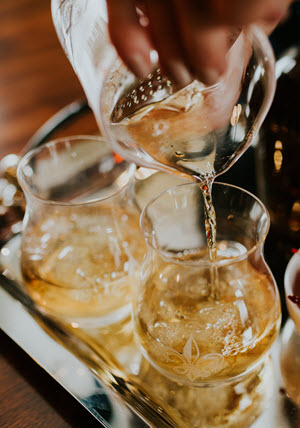
Tasting bourbon truly engages all the senses. Begin by looking at the liquid in the glass. What color do you see? Generally, the darker the color, the longer it has been aged. Swirl it around in the glass a bit. Just like wine, bourbon will have “legs” that drip down the inside of the glass. The thinner the legs, the higher the proof. Bourbons also have different viscosity. Some may be thick, oily, or water-like.
The next step is “nosing” the bourbon. Begin by swirling the liquid around to incorporate air and release some of the alcohol. This will help release more of the aromas. With your mouth open, take a sniff. Be careful not to stick your nose straight into the glass. The alcohol vapors from a high-proof bourbon can numb your nose. Take it slow and gently inhale the aromas of the bourbon. Place the glass down for a few seconds, take a deep breath in and out to clear your senses, and then take a second sniff. What do you smell? Grasses, nuts, fruits, spices, herbs? Take time to focus and concentrate, and write down your first reaction. Sometimes we smell things but do not have the language to describe it. That is where a flavor wheel can come in handy. When nosing a bourbon, there is no right or wrong answer. You smell what you smell, but I have learned that the power of suggestion can influence your perception.
The next step is actually tasting the bourbon. This is a good point to remind your guests that they should be sipping the bourbon and not shooting it like a Jäger bomb. They are going to come back and experiment with the different bourbons so they should conserve the samples you have provided. To truly capture all of the flavors of bourbon, you want to take a small sip and roll it around in your mouth. This was aptly named the “Kentucky Chew” by Fred Noe, master distiller of Jim Beam. Let it coat your tongue, taking note of where you feel and taste it the most. Is it on the back of your tongue, the sides, or right in the middle? How does it feel when you swallow it? Does it have a smooth finish or does it burn going down? How long does the burn last? Note how the bourbon feels in your mouth: is it oily, thick, or just plain hot? If you can feel it in your throat and your chest, that is called the “Kentucky Hug.”
After taking your first sip, pause a moment and then take a second sip. Does anything change? Note the differences. Referring back to your flavor wheel, write down the flavors you taste. It is important to note that not everyone will taste the same thing. Some palates will pick up on flavors that even the master distiller never catches, and some can only distinguish what they like and don’t like. One story I have heard many times is about a master distiller who was asked by an audience member how he got the cherry and vanilla notes in his bourbon to pop. The distiller paused for a moment and said, “Well, I don’t know about all of those things that people always pick out of our bourbon. I just know good bourbon and bad bourbon.” He then took a sip of his bourbon and declared, “That there, that’s a good bourbon!” Sometimes that is all you need to get from a tasting: a clear idea of what you like and don’t like.
For some palates, a straight taste of bourbon is too much. That is when we introduce other elements into the tasting. The first thing we recommend is that you begin by using your straw to add a single drop of water or a piece of ice. It is amazing what that will do to open the bourbon and allow the flavors to come through. In most cases it will soften the bourbon and smooth out the rough edges of the finish. Note the differences in flavors. Refer back to your flavor wheel to see if you are able to discern flavors much better than before.
To highlight the differences in the bourbon, experiment with accompanying flavors and textures. If the bourbon is still too strong, you can add a few drops of ginger ale. This will increase the sweetness but still allow the flavors of the bourbon to come through. I always like to have a few small bites available to demonstrate how food can influence the palate and bring out certain flavors and depress others. We have paired bourbon with chocolates, nuts, olives, dried fruits, cheeses, and smoked meats, but nothing is off-limits. Move around the different bourbons in your lineup. Tasting different bourbons back to back can reveal aspects of the spirit that you didn’t previously notice. Take notes along the way.
After you have had a chance to sample and taste and figure out what you like or don’t like, look for similarities in your choices. Are they close to the same proof or age? Are they all single barrels or small batch? Do they seem to come from one single producer? Do they have a similar mash bill? Are they all bottled in bond? Now that you know what all of this means, you can confidently walk into any bar and order what you like the way you like it.
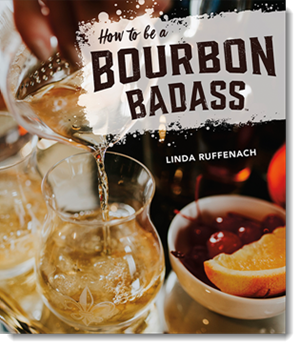
Please help to support Distillery Trail. Sign up for our Newsletter, like us on Facebook and follow us on Twitter.


